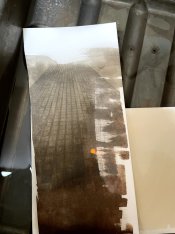grainyvision
Subscriber
I've been trying to find info about the chemistry that makes Kallitype work, and I think I understand it to an extent, but I do not understand how the developer ties into it. There's a few often used developing agents include:
* acetate
* citrate
* oxalate (references to it, but very little documentation)
* tartrate (rochelle salts)
And all of these salts used in extremely high volume amounts, nearly at the saturation point typically, and often kept at least mildly acidic.
I'm trying to understand why these salts are used and why not acidified distilled water (similar to cyanotypes)? I've personally tried potassium oxalate, sodium citrate, and (just recently) triethanolamine acetate (acetic acid + triethanolamine). All seem to work similarly but with distinct tone differences. Citrate is typically very warm and orange. Oxalate can be extremely cold toned, even blue on some papers but can be orange on some papers too, and triethanolamine acetate I haven't tested enough, but it seems to be a warm deep brown with cold highlights in initial tests. All developers kept acidic using the acid version of the salt (ie, citric acid, oxalic acid, acetic acid respectively). I know distilled water or diluted developers (even when acidic) also typically lead to staining in highlights.
I don't understand how each different developer produces different tonalities, or what actually makes this work in this case. I understand chelating and clearing is important, but that's the clearing bath and not the developer. My understanding is actually more that a chelating agent would prevent development, but obviously that isn't the case. Does anyone have anything to read on this subject? I see a ton of "how to kallitype" but very little "how kallitypes work" type information. There's one previous thread here thats old but also didn't go into what makes a developer work for the process, just suggesting potential developers
* acetate
* citrate
* oxalate (references to it, but very little documentation)
* tartrate (rochelle salts)
And all of these salts used in extremely high volume amounts, nearly at the saturation point typically, and often kept at least mildly acidic.
I'm trying to understand why these salts are used and why not acidified distilled water (similar to cyanotypes)? I've personally tried potassium oxalate, sodium citrate, and (just recently) triethanolamine acetate (acetic acid + triethanolamine). All seem to work similarly but with distinct tone differences. Citrate is typically very warm and orange. Oxalate can be extremely cold toned, even blue on some papers but can be orange on some papers too, and triethanolamine acetate I haven't tested enough, but it seems to be a warm deep brown with cold highlights in initial tests. All developers kept acidic using the acid version of the salt (ie, citric acid, oxalic acid, acetic acid respectively). I know distilled water or diluted developers (even when acidic) also typically lead to staining in highlights.
I don't understand how each different developer produces different tonalities, or what actually makes this work in this case. I understand chelating and clearing is important, but that's the clearing bath and not the developer. My understanding is actually more that a chelating agent would prevent development, but obviously that isn't the case. Does anyone have anything to read on this subject? I see a ton of "how to kallitype" but very little "how kallitypes work" type information. There's one previous thread here thats old but also didn't go into what makes a developer work for the process, just suggesting potential developers


 The latter uses FAC that requires only water to develop like cyanotypes. End product in both cases is same - image formed by silver metal.
The latter uses FAC that requires only water to develop like cyanotypes. End product in both cases is same - image formed by silver metal. 
